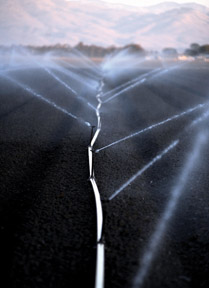Note: This is part of a new feature in which two writers share opposing views on local topics.
San Benito Rising is a grassroots group of farmers, ranchers, vintners, business owners, political leaders, teachers, workers and retired people who came together approximately 13 months ago. After gathering more than 4,000 signatures during April of this year, SBR has placed an initiative on the ballot in November to ban “high-intensity” petroleum operations in the unincorporated parts of the county. The initiative allows conventional, “low-intensity” oil drilling to continue uninterrupted in agricultural and manufacturing zones, or 97% of the county. We are now the Coalition to Protect San Benito, made up of many groups in the community, including San Benito Rising, with a common interest to protect the water, health and future of San Benito County.
The petroleum industry began developing “high-intensity” methods when oil closer to the surface, recoverable by the conventional methods, began to dry up. These high-intensity methods include fracking, acidization and cyclic steam injection, which could all potentially be hazardous to our way of life in San Benito County.
Fracking
Fracking is an oil extraction process that injects millions of gallons of water, mixed with sand and toxic chemicals into a well. These wells could be over two miles deep and run a mile or more horizontally. The objective is to fracture the shale layer of the earth’s crust to release high-sulfur, heavy crude oil. In 2011, the U.S. Energy Information Administration (EIA) estimated that the Monterey Shale Formation (a 1,750-square-mile portion of the state) stretching from the San Joaquin Valley to Los Angeles Basin could contain 15.4 billion barrels of recoverable oil. Approximately two-thirds of the nation’s shale oil reserves. Based on these estimates, the oil industry claimed that millions of jobs would be created and billions in state revenue generated for the state. After further research, this year the EIA dramatically reduced their estimate from 15.4 billion barrel to 0.6 billion or a reduction of 96%. While it is believed that the large oil companies may pull out of the Monterey Shale, smaller operators will continue drilling to find the “sweet spots” thus risking the contamination of our water and air. Furthermore, this method of drilling has induced earthquakes.
Acidization
In the fracking process, oil companies drill horizontally along the shale layer to release oil. But the Monterey Shale is a rock formation that is typically folded and shattered by geological faulting action, thus making fracking less effective. So oil companies are using a process called acidization to get to the Monterey Shale oil. Acidizing involves the injection of high volumes of hydrofluoric acid (“HF”), a powerful solvent, into the oil well to dissolve rocks deep underground. This allows oil to flow up through the well. As a powerful corrosive, HF dissolves nearly anything. HF is one of the most hazardous industrial chemicals in use. Currently, large amounts of HF (precise volumes are an industry secret) are routinely trucked around California and mixed at oilfields. It is a disaster waiting to happen.
Cyclic Steam Injection
Using this technique, also known and “huff and puff”,” super-heated hot water vapor is injected at high pressure underground to melt extra-heavy crude that is too tar-like to be easily extracted through conventional drilling. Steam injection is by far the most energy intensive and water intensive method used in California oil extraction. Because it uses so much water, cyclic steam can deplete aquifers. In addition, when a well has been “steamed”, a large amount of contaminated wastewater (“produced water”) is generated that is toxic to wildlife and ranch stock. This wastewater often contains salts, heavy metals and radioactive substances, which can leak into and pollute groundwater and surface water. In Kern County, which has the worst air and water quality in our state, a number of sinkholes have been linked to cyclic steam injection. Cyclic steam injection wells have recently been drilled in San Benito County by Citadel Oil Corporation. Their wells are presently being drilled six miles south of Pinnacles National Park in the “Project Indian” oil field, located near various earthquake faults, including the San Andreas Fault. Since cyclic steaming can cause earthquakes, it makes this project a potential problem!
On July 7, 2014, the state’s Division of Oil and Gas and Geothermal Resources issued an emergency shutdown of 11 oil and gas waste injection sites in the drought-stricken Central Valley. The state agency acted out of fear that oil companies may be pumping fracked fluids and other toxic waste into drinking water aquifers.
In another recent ruling related to water use and contamination, a Monterey County Superior Court judge ruled that San Benito County unlawfully approved the Project Indian oil field (mentioned above) near the Pinnacles National Park. The court found that the county failed to consider that this oil field could induce huge water usage, water pollution risks, greenhouse gas emissions and threats to the California candor.
Reasons to support the November ballot initiative
1) High intensity oil extraction will use millions of gallons of water during an extreme drought.
2) These extraction methods can pollute our aquifers with toxic chemicals.
3) High-intensity oil extraction can cause earthquakes such as those experienced in Oklahoma.
4) California is one of the few states that does not have an oil and gas severance tax. Very little revenue will be generated for the state.
5) Any potential jobs will probably be filled by workers from the oil fields of San Ardo, Coalinga or King City, not the residents of San Benito County.
6) Health problems such as asthma and higher incidences of certain cancers are associated with high-intensity oil extraction.
7) Our property values could potentially be devalued by contaminating our environment.
8) The residents of San Benito County want to preserve the natural beauty and agrarian life style of their county.
In summary, the citizens of this county will be given an opportunity to determine the quality of life they want for their families and community. If you are tired of corporations and politicians making decisions that may be detrimental to your welfare, in November you will have the opportunity to ban fracking and other extreme methods by voting “Yes on Measure J.”










